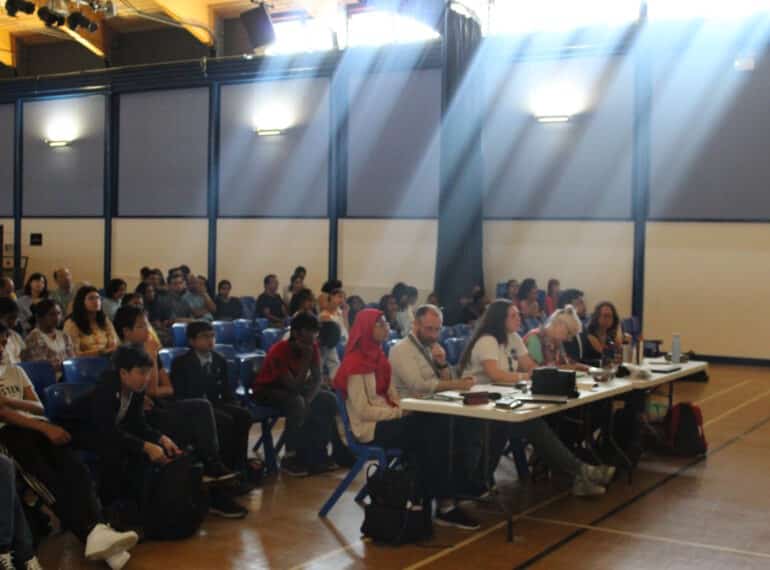
Teams from QE and The Henrietta Barnett School aimed to turn science fiction into future reality when they planned for a settlement of the red planet in a space design competition.
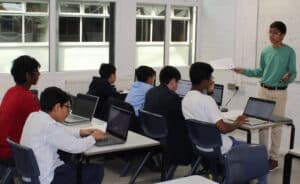 Four teams – two from each school – battled it out in the Galactic Challenge, which was hosted by QE. Helping out on the Saturday of the competition were a trio of Old Elizabethans who are themselves veterans of space competitions.
Four teams – two from each school – battled it out in the Galactic Challenge, which was hosted by QE. Helping out on the Saturday of the competition were a trio of Old Elizabethans who are themselves veterans of space competitions.
Their one-day mission: to boldly produce proposals for an Earth–Mars cycler settlement – a future orbiting hotel which would ferry 1,000 people to and from Mars in six to 14 months following a ‘cycler’ trajectory that regularly intersects the orbits of the two planets.
QE Head of Physics Jonathan Brooke said: “The boys presented with great skill and confidence. The proposal from both QE teams were thorough, dealing carefully with key challenges from the RFP [Request for Proposal – which reflected a typical design brief in the space engineering industry].”
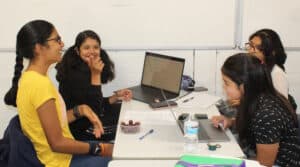 Galactic Challenge, which is for students aged 10-14, is the sister competition of the UK Space Design Competition (UKSDC), which is for those aged 15–18.
Galactic Challenge, which is for students aged 10-14, is the sister competition of the UK Space Design Competition (UKSDC), which is for those aged 15–18.
The 12-strong teams each formed fictional aerospace companies: Astrodyne Delta; Columbus Aviation; Infinity Airspace, and Solaris Flight Systems. They elected company officers within the team, such as the company president, and vice-presidents. The CEO roles in each company were undertaken by Year 12 volunteers, who were there to guide and mentor the Key Stage 3 teams, rather than to lead. The QE CEOs were Soumil Sahjpall and Haradhat Ramanathan.
Teams were transported 60 years into the future, to the year 2083, where space travel might be commonplace.
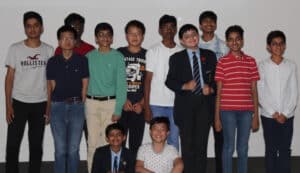 The RFP asked companies to deal with various challenges. These included:
The RFP asked companies to deal with various challenges. These included:
- Critical systems – for example: how the settlement would be powered; how liveable conditions would be maintained; how passengers would be fed
- Emergency response, including an evacuation procedure for the settlement
- Workforce issues, including use of automation
- Marketing and ensuring that the venture could be an economic success.
Now in Year 13, Soumil said: “Volunteering as a CEO was both fun and rewarding. The students were very keen, creative and enthusiastic.” His group, had researched well and learnt quickly “to compile a great proposal and presentation for the judges, including a CAD (computer aided design) and a promotional film”.
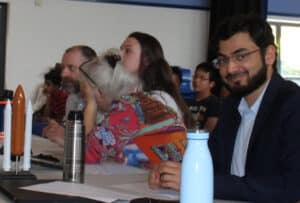 The judges’ panel featured staff from the Space Science & Engineering Foundation, QE Head of Physics Jonathan Brooke, Dr Flore Faille, Head of Physics at HBS, and Aadil Kara (OE 2010–2017).
The judges’ panel featured staff from the Space Science & Engineering Foundation, QE Head of Physics Jonathan Brooke, Dr Flore Faille, Head of Physics at HBS, and Aadil Kara (OE 2010–2017).
Aadil’s QE contemporaries, Sam Bayney and Harikesan Baskaran, were among those helping out on the day.
Aadil, Sam and Harikesan were all part of a QE Sixth Form team that won the regional heat of the UK’s Space Design Competition and went on to the 2017 national finals, where Aadil was selected to take part in the International Space Settlement Design Competition in Florida.
Aadil has for several years supported both Galactic Challenge and the UKSDC, and is a member of the UKSDC board. A Senior Analyst with the Cabinet Office, he graduated with a first in Physics from Imperial College London.
After the event, Mr Brooke reflected on the successful partnership event between QE and HBS and on the performance of QE’s teams: “I was particularly impressed by the meticulous attention to detail that Solaris applied to the financial side of their proposal.”
Once all the competition was done, however, final victory went to Columbus Aviation, one of the HBS teams.
